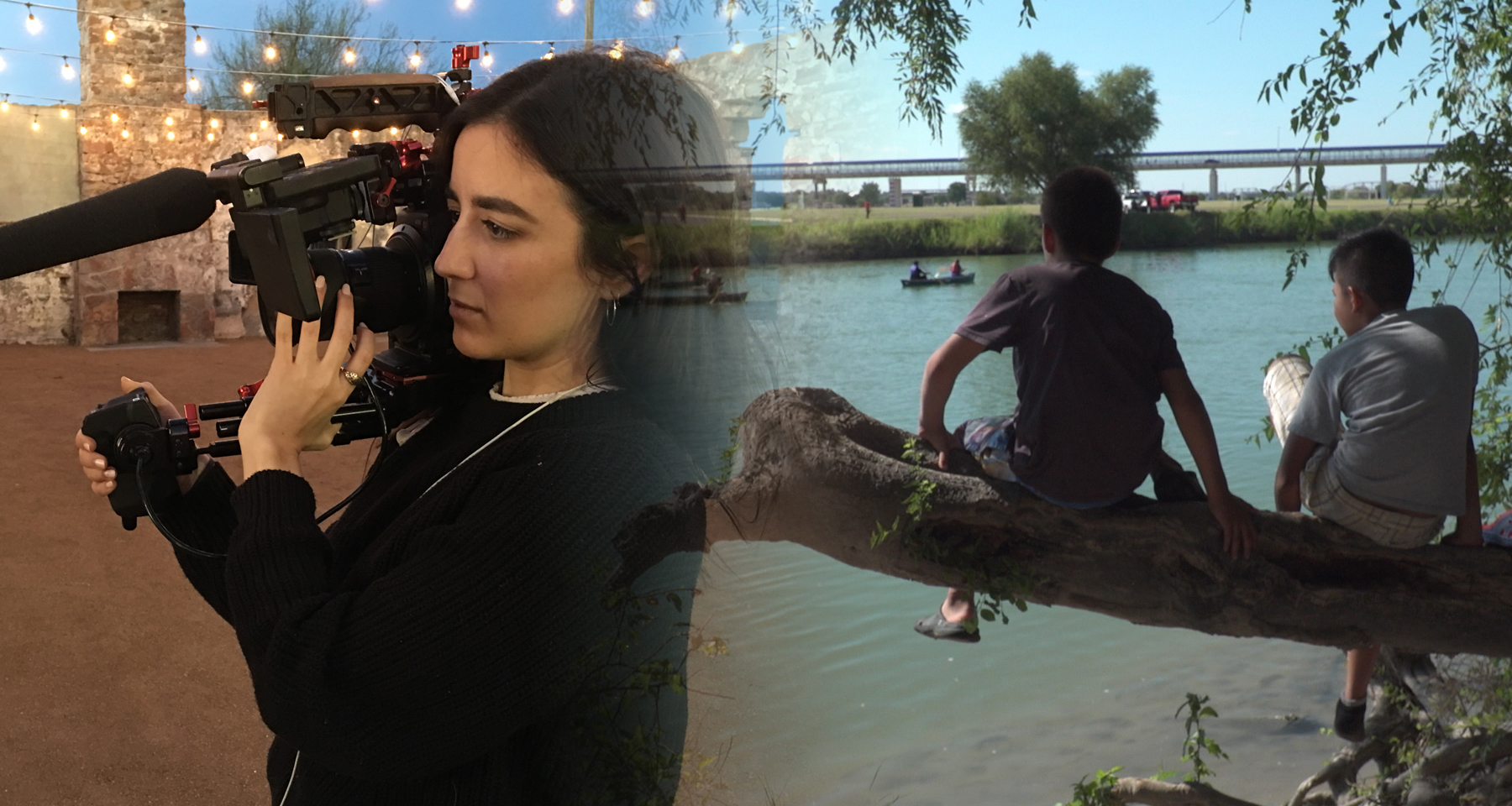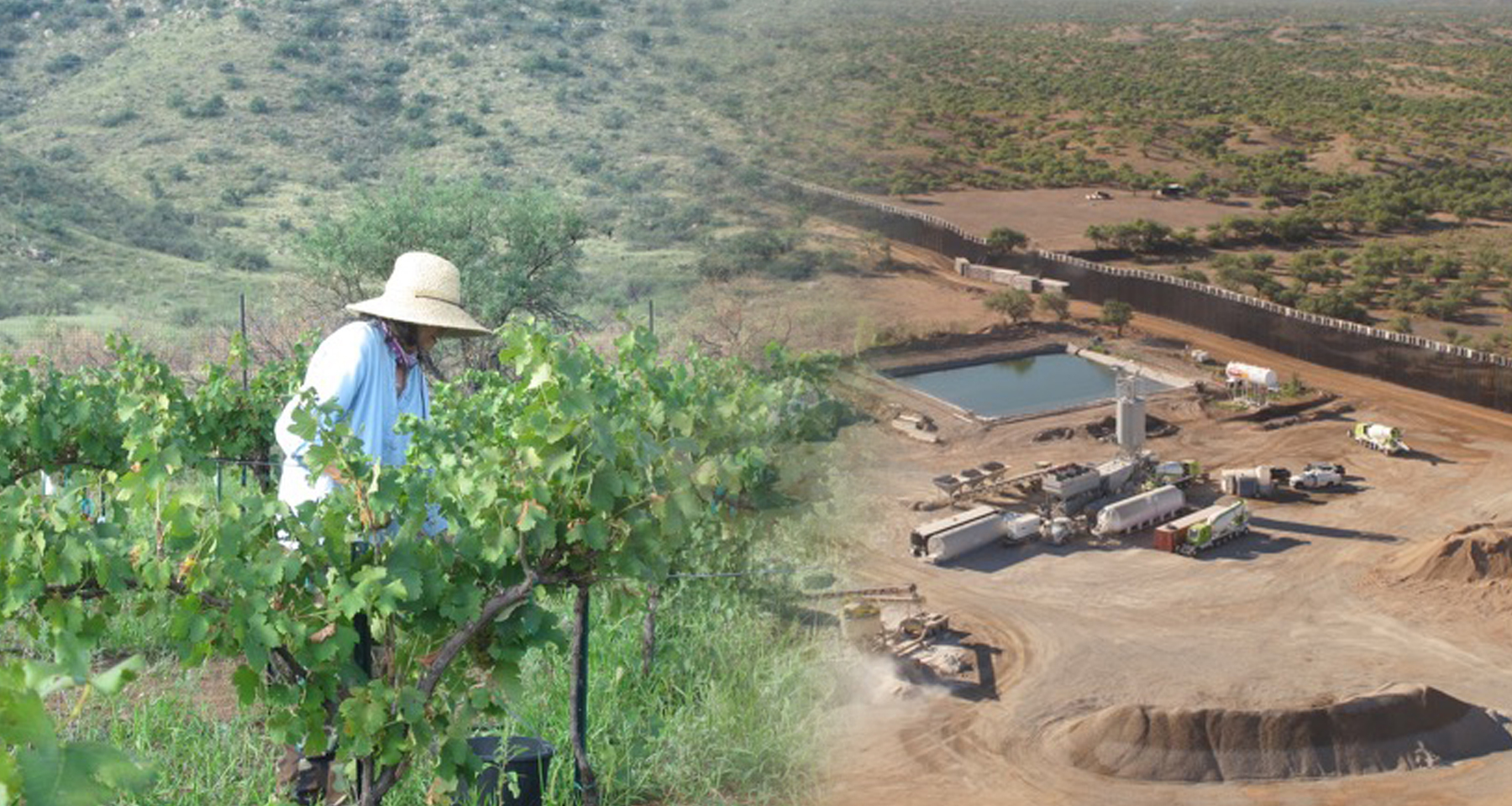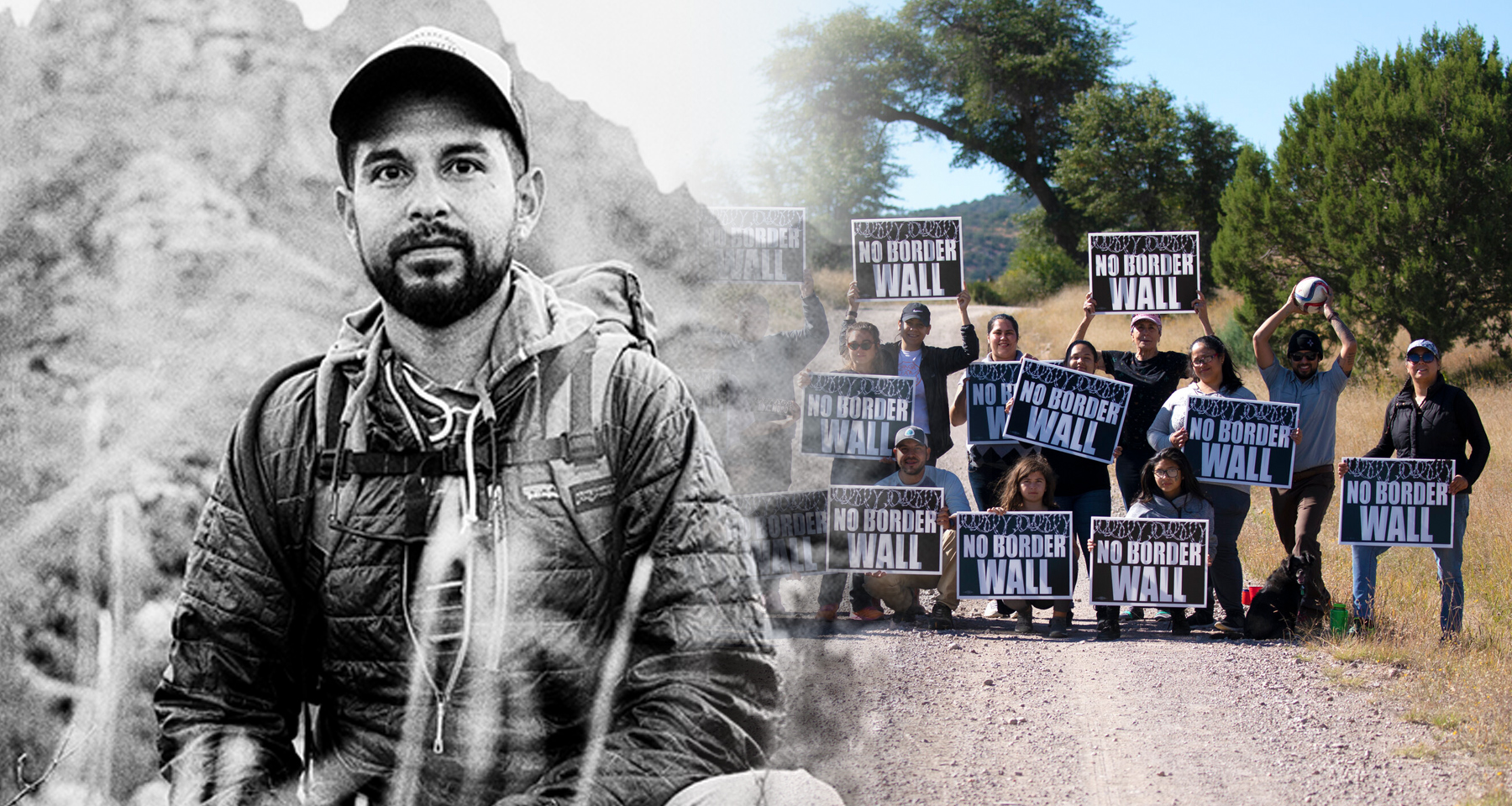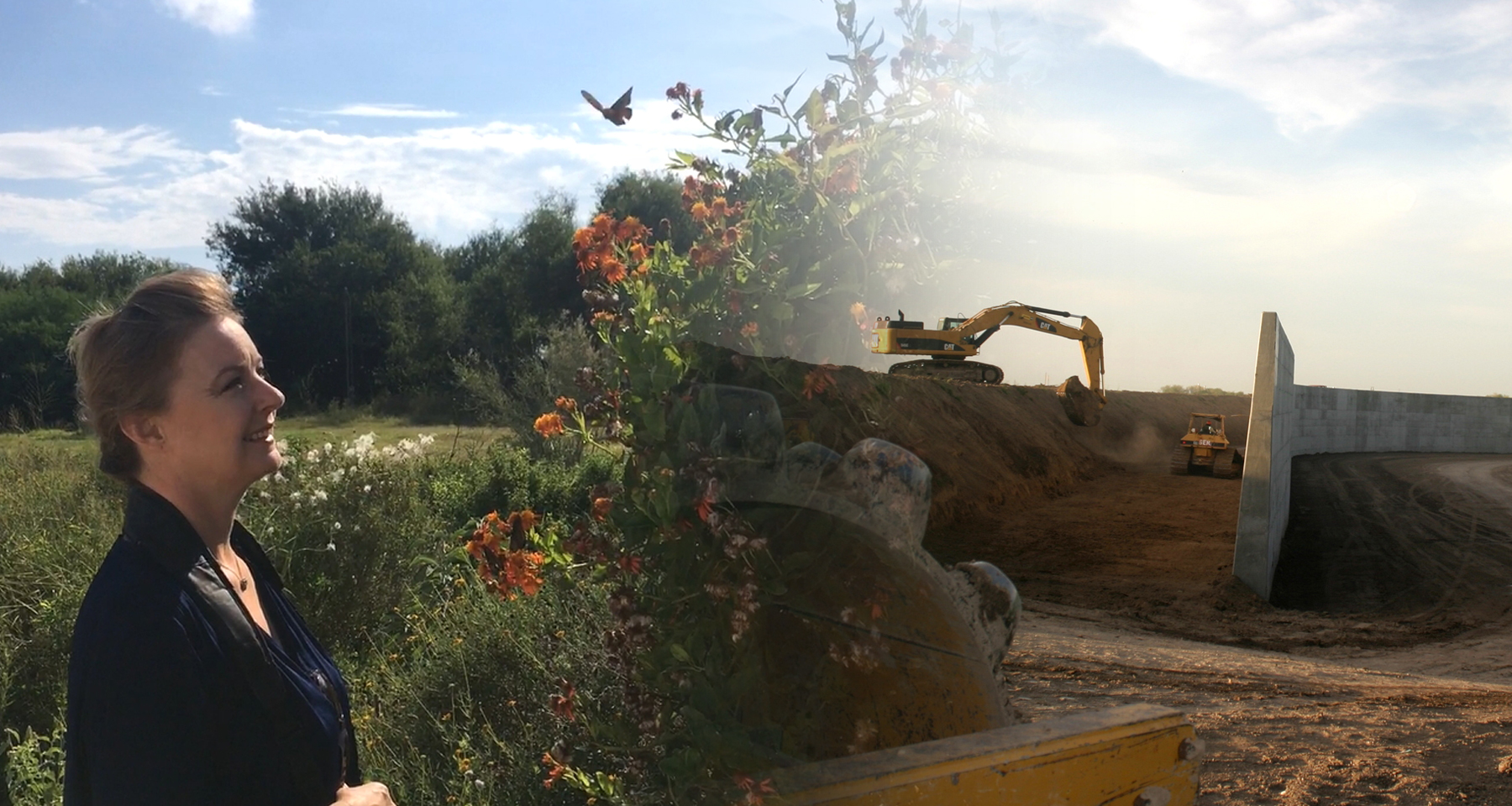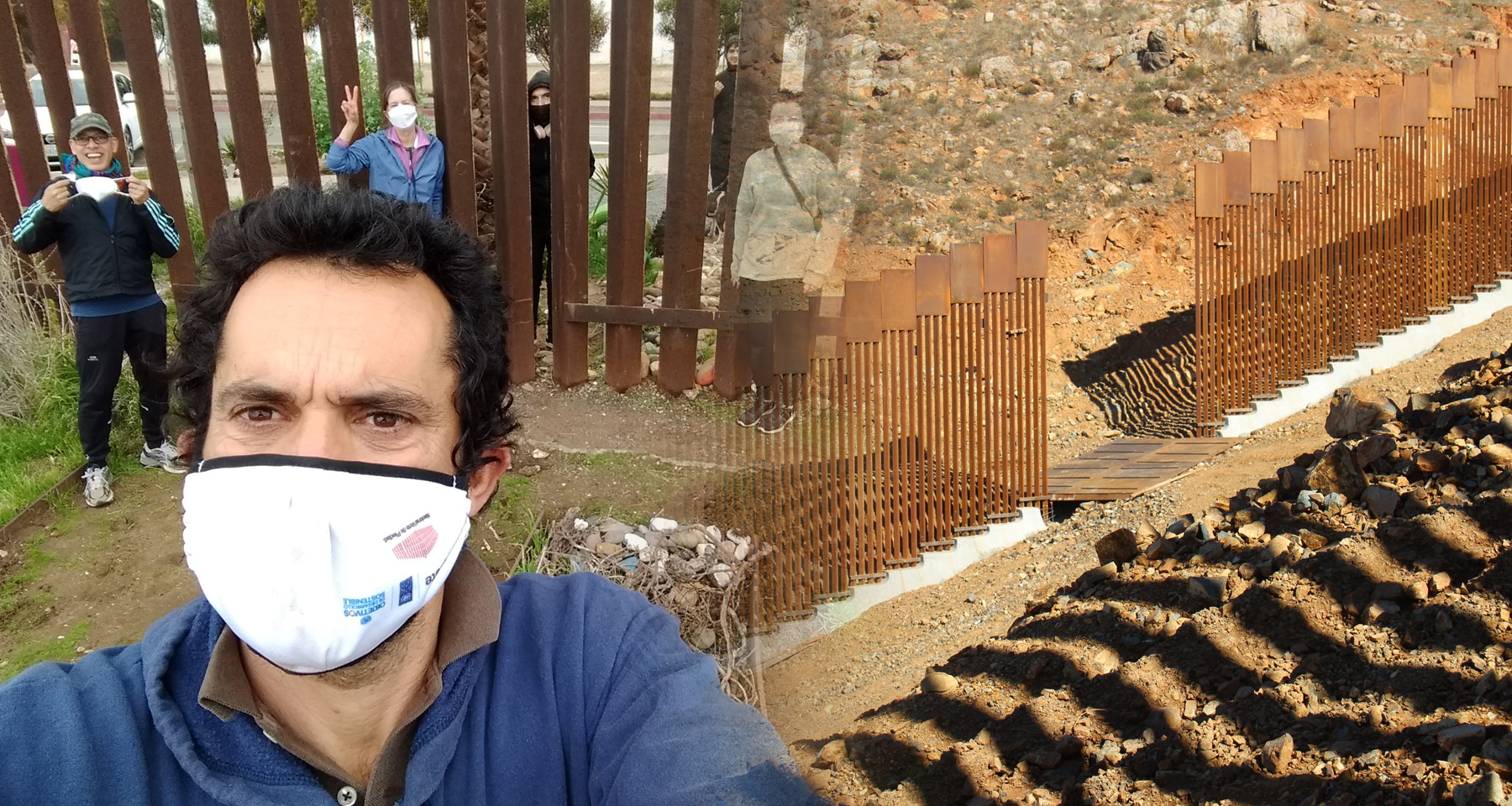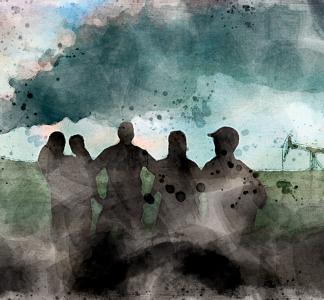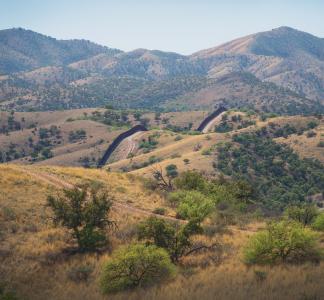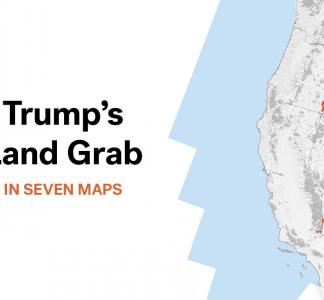Crossing the divide: 5 stories along the U.S. border wall
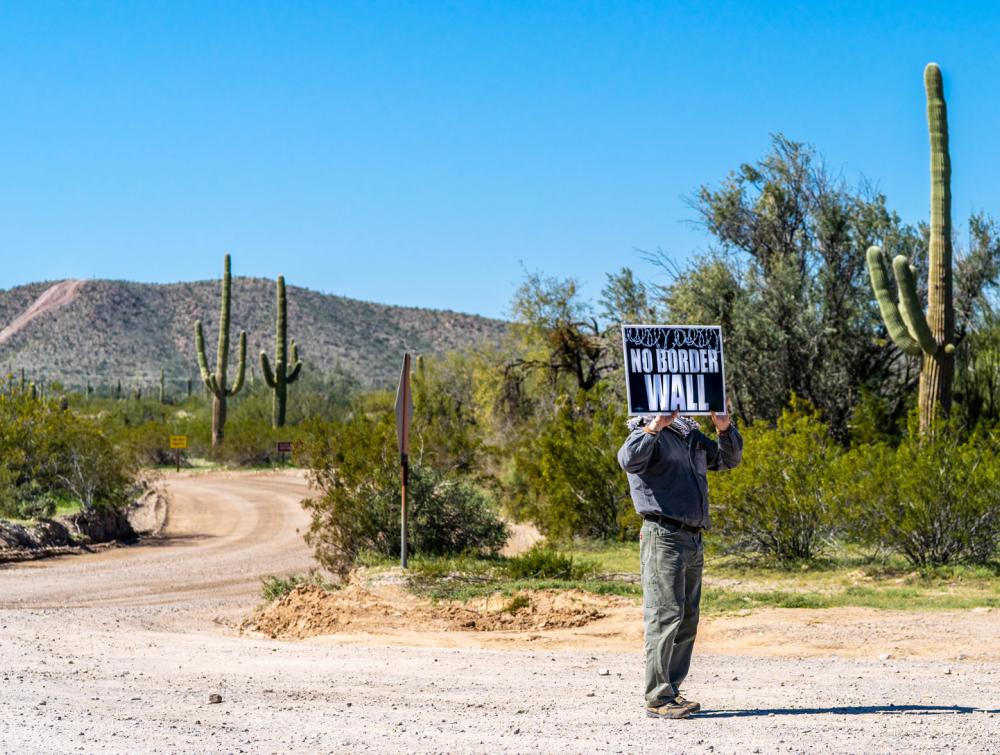
Protest at Organ Pipe Cactus National Monument, Arizona
Jim Gillett
Stories of borderland residents highlight wall's toll—physical and symbolic alike
"Growing up, my father always said we live in the United States Demilitarized Zone,” says Marianna Treviño-Wright. Her family came to Texas when she was a kid and she grew up in the Rio Grande Valley, close enough to the southern border to gain a fine appreciation for the region’s mingling of cultures, languages and peoples, as well as its generally amicable atmosphere as a crossroads between the U.S. and Mexico.
“But that is no longer the case,” she adds. “It is a fully militarized zone [now].”
Treviño-Wright, who lives in McAllen, Texas, just a few miles from the border, is talking about the growing presence of federal and municipal law enforcement, often bristling with imposing tactical gear. She's talking about the U.S. Border Patrol agents she regularly sees hanging out in SUVs, waiting for some action. And of course, she’s talking about The Wall, which looms over borderland communities in four states. The border fence build-up began decades ago but took an exponential leap forward under the Trump administration. Trump utilized a declaration of a national emergency and a provision in the Real ID Act of 2005 to waive critical environmental laws and direct billions of taxpayer dollars to the wall.
One resident says the area along the U.S.' southern border is "a fully militarized zone now"
Almost immediately after being sworn in to succeed President Trump early this year, President Biden signed an executive order halting construction of the border wall. He also launched a 60-day review of the massive project. What happens next is not entirely clear.
What is clear: Communities across the Southwest had little or no input on whether a towering steel wall would be the solution to complex immigration issues. Indeed, the current head of the Department of Homeland Security, Alejandro Mayorkas, has testified that he doesn’t think the U.S. should pursue “a monolithic answer to that varied and diverse challenge."
But concerns are mounting about what will happen to the unfinished wall construction sites and whether or how the Biden administration will have the most damaging sections of border wall removed.
“I don’t have any optimism,” says Treviño-Wright of this pivotal moment. “I just have fury and a fierce determination to uphold truth and justice.”
A toxic symbol, and a real threat to communities and wildlands
Many initially discounted the renewed wall construction as just a canny, cynical stunt cooked up by a xenophobic reality tv host-turned-presidential candidate. Even after his election, Trump’s promise of a wall extending from the Gulf of Mexico to the Pacific Ocean, paid for by Mexico, seemed laughable.
But there wasn’t anything funny about it to those who had already endured decades of neglect in borderland regions and watched their communities smeared by media as lawless or violent. And it certainly didn’t strike them as droll when the bulldozers arrived to tear through cherished wilderness areas and wildlife refuges; when dynamite was used to clear construction paths through ancient Native American burial sites and mountain wilderness areas; or when land on either side of the wall came to resemble an active war zone.
The daily damage the wall has done to life along the border makes it so much more than a symbol. It has cleaved communities and families, pummeled sensitive landscapes, blocked animals’ migratory routes and drained precious desert aquifers.
Below, we’ve collected the stories of borderland residents who see the toll of the wall—both symbolic and tangible—and steadfastly oppose it. We hope their experiences will offer some insight into the damage already done, and a window into some possible paths forward.
Robie Flores (Texas)
“Changing that narrative, where we are constantly villainized, is at the heart of it.”
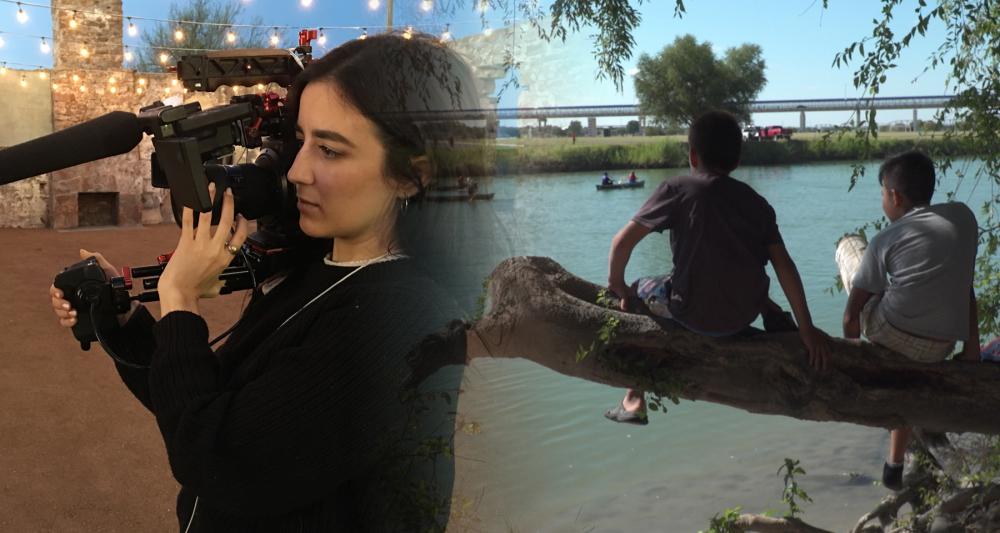
Robie Flores is an independent filmmaker who is working on a documentary about growing up near the border between the U.S. and Mexico.
Robie Flores
Eagle Pass, Texas, developed out of what’s considered the first American settlement on the Rio Grande, and in some ways the town—about 130 miles southwest of San Antonio as the namesake raptor flies—has retained the character of a far-flung outpost. At the very least, says Robie Flores, an independent filmmaker who is working on a documentary about growing up near the border between the U.S. and Mexico, Eagle Pass has stayed out of the spotlight. “The message I got about my home my entire life was that we’re on our own, especially because we’re so far from any other major city,” says Flores. “You grow up not seeing yourself reflected in anything that you are seeing and consuming.”
And when borderland communities like Eagle Pass do show up in popular media or otherwise break through to the public consciousness, it’s rarely for good reasons, or in a light that reflects Flores’ memories of a “pretty chill” childhood at the vibrant nexus of two nations. You don’t see yourself in TV or movies unless “it’s just about dangerous places and illicit activities,” a factor she says makes it harder for people to feel proud of their background and less willing to advocate on issues that affect their community.
People in borderland communities don’t see themselves in TV or movies unless “it’s just about dangerous places and illicit activities,” a factor Flores says makes people less willing to advocate on issues that affect them.
With her brother, Alejandro, Flores is co-founder of a group that protests against efforts to turn the old border fence between Eagle Pass and the city of Piedras Negras, which lies just across the Rio Grande in the Mexican state of Coahuila, into a 30-foot barrier that would cut through public parks and sensitive wildlife habitat. If completed, the wall may prevent families from seeing each other and destroy the local economy. There’s no doubt that the relentless narrative of violence at the border has buoyed support for the wall and made the Flores’ task much more challenging.
Actual data show that communities along the border with Mexico are among the safest in the U.S. One conservative think tank has reported that if the rest of the country had crime rates similar to those along the border, we’d see a dramatic nationwide reduction in homicides and other crimes. In 2014, before former President Trump had begun stoking fears about immigration in earnest, a sheriff from Brewster County, which abuts the border some 150 miles to the west of Eagle Pass, told The Texas Observer he advises fretful tourists from Houston that there’s less danger to be found near the border than back home: “We’ll say, ‘hurry up and get out of there! It’s safer here than where you’re coming from.’”
Flores’ mission as a Fronteriza (border-dweller) and documentarian is to push back against the scaremongering that surrounds communities like Eagle Pass and has been used so successfully to build political support for the wall. “The narrative of our home has been completely hijacked,” she says. “It makes it easier to put up a wall that harms animals, the ecosystem, and native lands.”
Instead, she wants to tell stories about the culture of “survival and creativity” that surrounds Eagle Pass: “When we say ‘border’ or ‘frontera’ we think family, we think childhood, we think food, parties, ambiente – all of those things.”
“Changing that narrative, where we are constantly villainized is at the heart of it,” Flores concludes. “People won’t fight for their home if they don’t think it has value, that it matters.”
Melissa Owen (Arizona)
“When I turn on the faucet, it’s like cutting my wrist and watching the blood come out. That’s how important water is to us down here.”
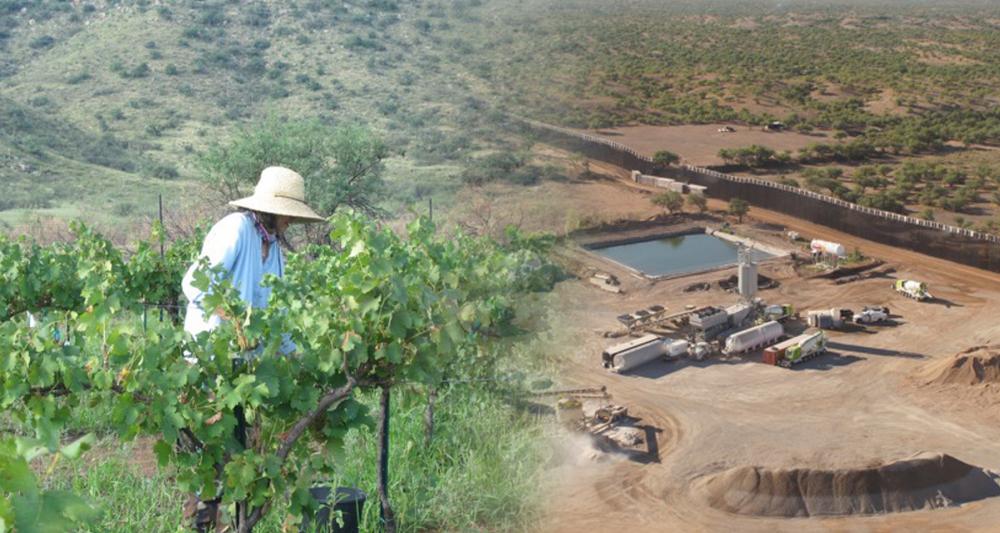
Left: Melissa Owen tends to her vineyard. Right: A water holding tank seen from the air at a construction site near the border wall.
Melissa Owen
The connection between water supply and a wall on the border might not be immediately evident to many across the U.S. That (understandable) ignorance is a luxury not available to residents of the Southwest, whose lives and livelihoods are clearly delineated by the climate change-warped, boom-and-bust rhythms of melting mountain snowpack, desert streams and underground aquifers.
“Every morning when I turn on the faucet, it’s like cutting my wrist and watching the blood come out. That’s how important water is to us down here,” says Melissa Owens, whose ranch in Sasabe, Arizona, is a few miles north of the border.
This weighs on her now, especially, because crews working for U.S. Customs and Border Protection (CBP) have pumped millions of gallons of groundwater from key desert aquifers here and elsewhere along the border so they can mix concrete for the wall, draining the sources that sustain both communities and sensitive habitat.
In the best-documented example, oasis-like wetlands in the San Bernardino National Wildlife Refuge started to dry up after the agency seemingly ignored numerous warnings from the U.S. Fish and Wildlife Service to avoid wells close to the refuge.
Similarly, a spring-fed desert pond in Organ Pipe Cactus National Monument, already depleted by agricultural uses, dipped to its lowest level in years in 2020, a phenomenon that may be linked to CBP water pumping. Quitobaquito Springs, as the latter area is known, is an important ceremonial site for the Indigenous people of the Tohono O’odham Nation.
Verlon Jose, former vice chairman of the Tohono O’odham Nation, was quoted as saying that the steel bollard walls carved across sacred lands felt “like if someone got a knife and dragged it across my heart.” In 2020 testimony before a House Homeland Security subcommittee, Tribal Chairman Ned Norris Jr. emphasized that “The Nation shares the federal government’s concerns about border security,” but nonetheless opposes the wall because “it is needlessly destructive when there are more efficient ways to control the border without damaging the religious, cultural and environmental resources on which our members rely and which make our ancestral land sacred to our people.”
“The damage that this is causing to the wildlife and to the wildlands down here is appalling,” Owen says. “We live in a very fragile ecosystem. We get maybe ten to twelve inches of rain per year,” and the refuge can't afford to have any of that diverted for construction crews.
Back on her southern Arizona ranch, Melissa Owen makes it clear she is not a proponent of “open borders”–an accusation hurled at many people who oppose border wall construction. “No one wants a safe border more than I. However, what is needed is a sane and equitable immigration policy, not a 30-foot barrier," she says.
Owen's ranch in Sasabe hugs the western boundary of Buenos Aires National Wildlife Refuge, where she has previously worked and volunteered. She fears the refuge is fated to end up like San Bernardino and Organ Pipe, disturbed by development and robbed of precious water. “The damage that this is causing to the wildlife and to the wildlands down here is appalling,” Owen says. “We live in a very fragile ecosystem. We get maybe ten to twelve inches of rain per year,” and the refuge can ill afford to have any of that diverted for construction crews.
As if all that weren’t bad enough, the government’s reckless use of water near the border is directly threatening Owen’s business, a small vineyard that had been up and running for about 15 years but now sits dormant. “We can’t irrigate a vineyard if we don’t know we’ll have enough water to drink,” she says. Owen has been told wall construction nearby uses about 110,000 gallons of water per day, but beyond that, the situation is a bit of a mystery.
“No one did any sort of hydrological survey. No one would tell us exactly how much water was being pumped,” she says. “No one knows where that water is coming from. Is it from the aquifer that I use on my ranch? Nobody knows. Are we going to run out of water? Well, nobody knows.”
Ángel Peña (New Mexico)
“The border wall has been there for a long time—but these days it really stands for something different, something hostile and harmful to the psyche.”
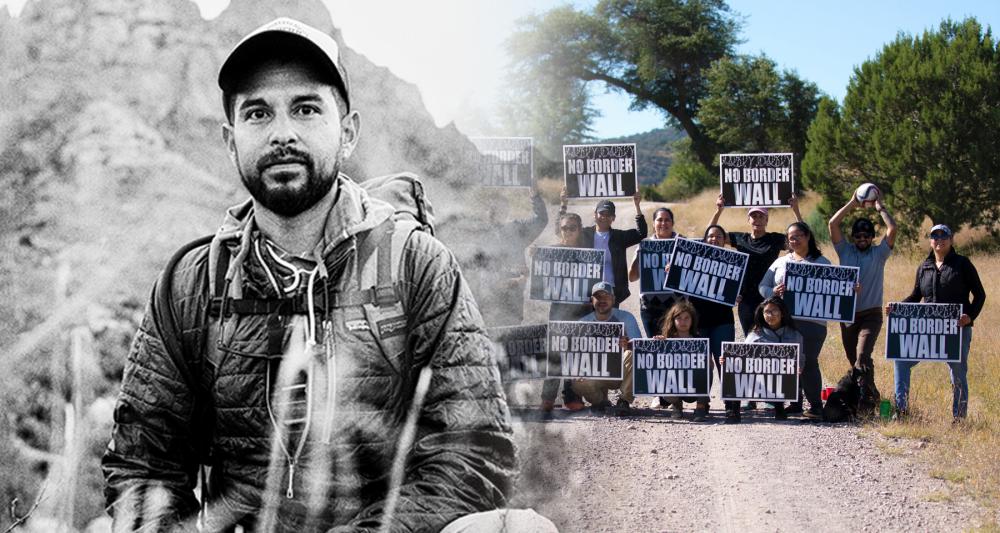
Ángel Peña is the president of the New Mexico-based Nuestra Tierra Conservation Project.
Left: Ángel Peña | Right: Nuestra Tierra Conservation Project
Take a blank sheet of paper. Now pencil in a rough map of North America. If your conception of the border between the U.S. and Mexico is anything like Ángel Peña’s, it less resembles the stark black line that typically separates the two nations in an atlas than a semipermeable membrane—purposefully porous, allowing cultural and economic exchange between families and communities.
Peña’s life experience bears that out. Father of three and a self-described first-generation Mexican-American, he is trained in anthropology and archaeology and serves as an advocate for the preservation of historic, prehistoric and cultural assets. Peña grew up within a couple miles of the border and has spent years moving freely with his family throughout the Juárez-El Paso-Las Cruces triangle. It’s been an enriching, binational experience, affording Peña and his children plenty of opportunities “to visit, eat good food and just live life.”
Enter Trump’s border wall.
“As someone who was used to going across the border to visit family and friends and share food, it really changed our way of life,” Peña says. He refers both to the structure itself and what it implies about the U.S.’ racially charged immigration debate: “When we do cross now you see these cages that were used to separate families. The border wall has been there for a long time—but these days it really stands for something different, something hostile and harmful to the psyche.”
“As someone who was used to going across the border to visit family and friends and share food, it really changed our way of life,” Peña says of the border wall.
Peña is the president of the New Mexico-based Nuestra Tierra Conservation Project, a non-profit that advocates for public land protection on either side of the border and opposes the wall. Nuestra Tierra maintains that wall construction and the ongoing militarization of borderland communities threatens an ecologically rich swath of the Chihuahuan and Sonoran deserts and Rio Grande Valley, including habitat for jaguar, black bear and other wildlife.
Since COVID-19 hit, Peña has been concerned with a specific threat that jeopardizes not only the region’s cherished cross-border cultural exchange, but the health of its residents. Clusters of temporary housing for construction workers, referred to as “man camps,” started popping up in southwestern states months ago to help expedite construction of the wall. But it was never clear what, if any, measures were being taken to screen those workers for coronavirus or prevent them from triggering community spread nearby. “We didn’t know where they came from, what precautions they were mandated to take to prevent spread of the virus, and they were flooding rural communities in New Mexico,” says Peña.
There were indications that some of the workers in these areas had come from as far away as Montana. Many even commuted regularly between their distant homes and the border-adjacent man camps, potentially exposing yet more people to harm. Borderland communities are already especially vulnerable to COVID-19 due to poverty, lack of communal resources and high incidence of underlying health problems. The man-camp workers, exempted from New Mexico’s statewide stay-at-home order and self-quarantine guidelines, threatened to make the problem even worse.
There’s no simple solution for cases like these. The bottom line, Peña says, is that efforts to negotiate relationships along the border must focus on those who are most at risk.
“What this new administration needs to do is prioritize people, especially those that have everything to lose, people who live in these rural communities in Luna or Hidalgo County of Southwest New Mexico,” he says. "Whether it’s the president or those working at the Bureau of Land Management or the Park Service: prioritize the people. Flora and fauna are important, but the culture and tradition is also valuable—and the people of the local communities are key to preserving the land and wildlife.”
Marianna Treviño-Wright (Texas)
“It is a fully militarized zone. The presence of law enforcement—from federal to municipal to everything in between—has grown exponentially over the last 20 to 30 years.”
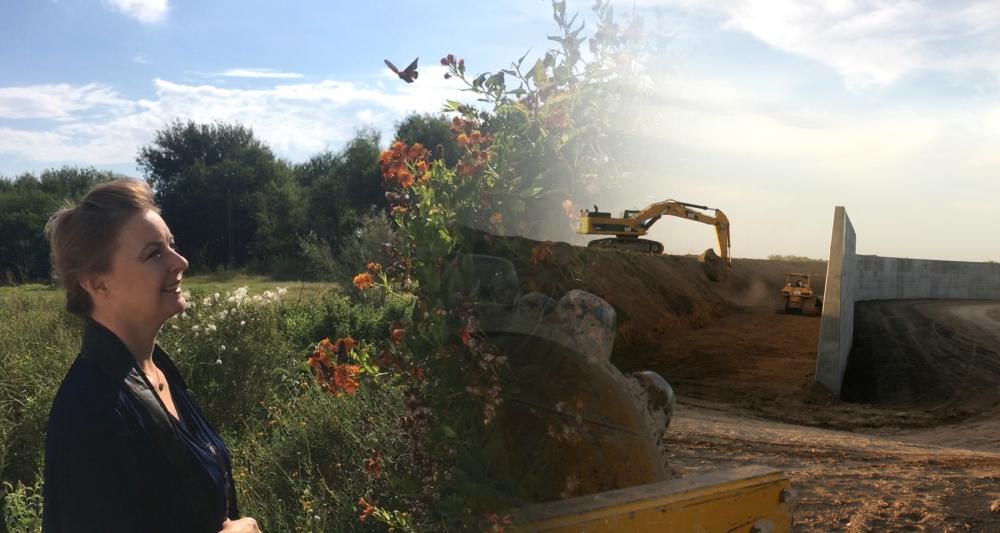
Left: Marianna Treviño-Wright at the National Butterfly Center. Right: A new "levee-wall" under construction.
Left: Marianna Treviño-Wright | Right: Scott Nicol
One of Marianna Treviño-Wright’s strongest messages about the wall between the U.S. and Mexico is this: “They’re taking your money and my money.”
What’s worse, they’re using it foolishly, and wrecking wildlands and communities in the process.
“They” includes U.S. Customs and Border Protection (CBP) and its armed tactical strike team; the federal government at large; corporations with an interest in selling surveillance and weapons technology; even the for-profit prison sector. Treviño-Wright says these directly or indirectly taxpayer-subsidized entities are all complicit in supporting not only the wall itself, but highly militarized conditions along the border. While border wall construction cuts through remote and ecologically sensitive areas, the flow of illegal drugs northward into the U.S., often cited as a reason for bulking up border security, overwhelmingly comes through legal ports of entry, including airports and seaports.
“The majority of people and drugs coming into the country are not pouring over the southern border where you would build a wall,” Treviño-Wright says of that justification. “That’s the reality. Not the false narrative that was crafted by people with a vested interest in selling concrete, steel, surveillance technology” and the like to the government.
Treviño-Wright would know. She serves as executive director for the National Butterfly Center, in Mission, Texas. Since 2017, the center has been a local ground-zero in the fight against the wall; that’s when The North American Butterfly Association sued the Trump administration over proposed border wall construction that would have cut right through it.
Apart from major constitutional concerns around the Trump administration's destruction of the center’s private property without permission or due process, wall construction activities could be disastrous for the butterflies and other wildlife. Treviño-Wright has said development here impacts key breeding and feeding territory as well as the health of the broader ecosystem.
Apart from major constitutional concerns, wall construction activities could be disastrous for the butterflies and other wildlife. Treviño-Wright has said development here impacts key breeding and feeding territory as well as the health of the broader ecosystem.
It’s tough for her to catalog all the ways the wall project has disrupted nature in the area. For starters, the government has been spraying herbicides along the border for years. They’ve compromised traditional earthen flood-control levees along the Rio Grande with adjacent concrete-and-steel “levee walls” that threaten to choke water flow and expose communities to dangerous flooding. As part of the border wall construction plan here and in numerous regions, Treviño-Wright says bright stadium lighting across the enforcement zone will disrupt the habits of birds, insects and other nocturnal wildlife.
In 2020, a federal appeals court decided a partial victory for the Lepidopterans and their ecosystem cohabitants. A D.C. Circuit majority ruled that CBP had entered and damaged parts of the National Butterfly Center without establishing that those activities fell under the Department of Homeland Security’s statutory authority to secure the border. The ruling sent the lawsuit back to lower court, a victory for the center. But the larger legal battle stretches on. In 2019, they filed suit over a stretch of (now completed) privately funded border wall that it says infringes on property rights. That challenge is still tied up in court.
Even though President Biden has halted wall construction, Treviño-Wright worries the stop-work order is less than solid and the center is still at risk. “The borderlands are American politicians’ piñata. They beat us every time they need to distract from some failure. All border wall contracts must be cancelled,” she says. That’s step one.
Treviño-Wright is under no illusion that there’s a simple, one-size-fits-all solution to regulating the border, especially in her section of the Lower Rio Grande Valley, where the river runs wide, deep and dangerous. But she knows the answer isn’t the “fully militarized zone” or the steel bollard wall we see now, miles from the actual border. To her, this new construction, both private and federally funded, is the product of a system that “is designed specifically to pour our tax dollars into the pockets of corporations.”
Dan Watman (Tijuana)
“They actually carved out the mountains in order to make roads and get their heavy equipment in … There [were] definitely endangered species that were damaged because of the construction.”
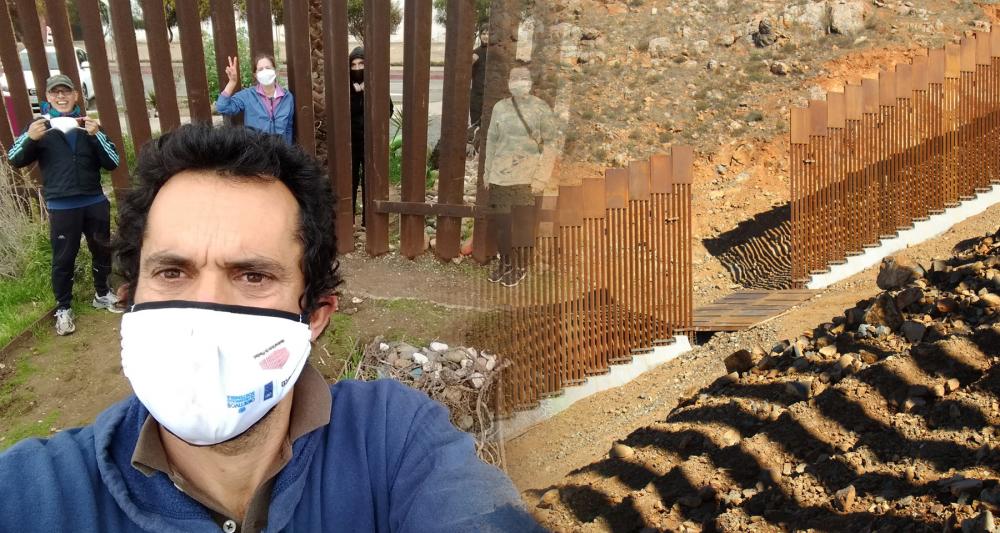
Left: Dan Watman, Tijuana-based founder of the Binational Friendship Garden. Right: A section of border fence in the Otay Mountains.
Dan Watman
Who would want to bulldoze something called a “Friendship Garden”?
The U.S. Border Patrol, evidently. In early 2020, an effort to uproot alleged smuggling activities between San Diego and Tijuana destroyed the U.S. side of the Binational Friendship Garden, a project within Friendship Park that is designed to bring people together over their shared love of cultivating plants.
According to Daniel Watman, founder of the garden and a Tijuana resident for nearly 20 years, the bulldozers rolled through with no warning. The non-profit that supports and advocates for the Binational Friendship Garden found no evidence of smugglers, and by the time Watman got wind of the razing, it was too late to stop it.
Border Patrol later apologized for the “unintentional destruction,” claiming they’d only meant to trim the garden. But the damage was done—perhaps more so to the spirit of Friendship Park than the actual garden, which volunteers, granted heavily restricted access, were permitted to begin replanting. Not only did the Border Patrol operation fail to increase security in the area, but it probably made things more dangerous by eroding the air of cross-border cooperation and friendship Watman and colleagues have worked so hard to create.
The situation reflects a prevalent and sadly limiting idea of what constitutes “security” at the border. Steel and concrete barriers—yes. Closer and more collegial relationships—no.
“Security and safety are also created when families can reunite, cross-border collaboration and cross-cultural understanding is promoted,” Watman says. “These are things that create trust and collaboration and contribute to security. But they are not even considered as part of policy.”
Friendship Park has been part of the tug-o-war over border issues for many years, but since Trump swept into office, it has been threatened like never before. A proposed border fence upgrade, part of the Trump border wall project, forced Watman to transplant parts of the binational garden and threatened to fundamentally change the environment. Friendship Park has long been a place where members of families broken up by immigration laws could spend a little time near each other, but that’s on pause right now. Access to the park is due to be reopened this June, but it isn’t clear the ideas of binational understanding and cooperation that animated its founding will bounce back from the Trump-era pall easily.
The situation reflects a prevalent and sadly limiting idea of what constitutes “security” at the border. Steel and concrete barriers—yes. Closer and more collegial relationships—no.
The park is also far from the only shared land in this region that’s been put in the crosshairs by Trump’s wall. To the east, a major development push has crowded into the Otay Mountain Wilderness over the last year. At the end of 2019, CBP began clearing the way for a three-mile segment of the wall to push through the mountains, at the edge of the wilderness area.
“They basically carved out the mountains. In order to build the wall and get down into really steep, deep canyons – they couldn’t get there with their machinery. So, they actually carved out the mountains in order to make roads and get their heavy equipment in,” says Watman. “That’s where I’ve been monitoring, documenting over the last year, the damage to flora and fauna. There [were] definitely endangered species that were damaged because of the construction.” Watman says wildlife whose habitat has likely been harmed by border wall activities include burrowing owl, bighorn sheep, northern harrier and barrel cactus.
The human toll of the border wall also weighs heavily on Watman. “It’s evident from the last 50 years of policy: more walls, more militarization, just means more people die crossing the border as they are pushed into more remote areas, and the more our environment is destroyed. It’s a failed policy. On top of that, the wall doesn’t work to stop people. I was just out there documenting, and on this 30-foot wall was a 25-foot long rope hanging.”
For now, he is keeping a close eye on Friendship Park (he’s able to see it from his apartment window in Tijuana). And he’s wondering what will happen after Biden’s border wall review deadline has passed -hoping it will include some kind of plan to help restore what’s been lost—a big step toward the original goal of his garden.
“I would be completely relieved if they decided ‘we’re not going to build this 30-foot wall – that contract has been cancelled,’” he says. “I would breathe a deeper sigh of relief if they decided to just take down the half-destroyed 18-foot wall. That would be the first step toward building a truly binational park.”
